When a Hot Cop Pulls You Over
by Matthew J.X. Malady
People drop things on the Internet and run all the time. So we have to ask. In this edition, writer Ruth Graham tells us more about what it’s like to be pulled over by a highway patrolman sent from heaven.
Just got pulled over by an absurdly hot cop, and he let me off with a warning. #usa
Ruth! So what happened here?
It was the 4th of July, and I was driving alone from my house in rural New Hampshire to join my very best friends at our summer rental in the Catskills. We have been renting this house together (in various combinations) since 2007, and it is my favorite place in the world. There’s a private swimming pond, and we cook big meals and have cocktails and play board games and make jokes and it’s just the best. We got Wi-Fi this summer, which has been a mixed blessing. That weekend there was going to be a much larger group than usual because my friends Alicia and Hugh were having a big co-ed bachelor/bachelorette party. They’re getting married this fall in Cleveland, and I can’t wait for their wedding.
Anyway, I work from home now, and it somehow hadn’t occurred to me that everyone else would have the day off and would have arrived at the house early. It was maybe 6 p.m., and I still had a few hours to go, so I was feeling a little rushed. I moved from New York to New Hampshire a couple of years ago, so now the drive is more than five hours each way.
I had just crossed the border on I-84 into New York from the East Coast’s equivalent of a flyover state, Connecticut (“Here I am at my destination in Connecticut,” said no one). Traffic wasn’t bad, and I was zipping along. I saw the “Speed Limit 55” sign — I’d been assuming it was 65 — at the exact same time I saw the state trooper parked in the median. I immediately knew he was going to pull me over, and then he did.
Once in high school I got pulled over and in a panic I unbuckled my seatbelt for some reason, and then I got a ticket for not wearing my seatbelt. So I always check to make sure my seatbelt is buckled when I get pulled over. There’s this little moment of “OK, pull yourself together, Graham.”
The officer came up to my driver-side window and leaned down, and when I saw his face I almost burst out laughing. It was ridiculous. He looked like Patrick Wilson had gotten into the best shape of his life, acquired the perfect tan, and then put on a crisp New York State Trooper uniform. He did not look like a real human. I was already on edge, of course, and his preposterous good looks did not help.
Hot cop: Ms. Graham, do you know why I pulled you over?
Me: I’m so, so sorry, I really thought the speed limit was 65 here.
Hot cop: Do you know how fast you were going?
Me: Probably like 78?
Hot cop, laughing incredulously (!!): Holy crap, you got it exactly right! That’s like the first time anyone has done that.
Me: Oh, should I have bluffed and said, like, 67?
Hot cop, still chuckling (flirting??): No, no, no.
We had a palpable connection, right? He walked back to his hot-cop SUV, and then he came back quickly enough that I was pretty sure I wasn’t going to get a ticket. “See what you get for being honest?” he said, passing me back my license and registration. “It turns into 65 just over the hill.” I thanked him, and I swear we were making sparkly, quasi-lingering eye contact at this point. This is probably a good time to mention that I am happily married.
As I drove off, my body was coursing with the combined adrenaline of avoiding an expensive ticket and flirting with an absurdly attractive man in uniform. “I’ve still got it!” I thought triumphantly. Then I looked down and noticed that my black blouse was visibly dusted with orange spices from the tube of Planters “Heat Peanuts” I had eaten a few hours ago. Obviously that made me question the whole flirtation narrative. Then I also started to think about how even if I did somehow charm my way out of the ticket, that represents a terrible imbalance in our criminal justice system. But it was all nice while it lasted. I drove to the house and told this story around the fire and it was a great weekend.
Aside from his hotness, in what ways was this officer different from other cops you’ve encountered in the past?
Well, he was just so nice! I know I said he didn’t look like a real human, but he acted like one, while still maintaining total professionalism. Though now that I’m thinking about it, maybe I’m just giving him credit for all of this because he was so good-looking and because he let me off with a warning. Ugh, it’s so unfair how sensationally attractive people with senses of humor, good jobs, charisma, and palpable kindness always get the benefit of the doubt.
Lesson learned (if any)?
Pay attention to the speed limit, especially close to state lines and on big drunk-driving holidays. Make nice with cops. Don’t tweet and drive (I tweeted from a rest stop!). Wear a cute outfit while traveling. Take time to enjoy the small, wonderful things that happen all the time. Brush snack dust off yourself before interacting with attractive people.
Just one more thing.
Recently I read about a survey that asked people, “When you see the American flag flying, how good does it make you feel?” It makes me feel extremely good. I am patriotic in an almost instinctual, emotional way. By that I mean, I think I have a healthy understanding of this country’s historic, appalling, even unforgivable flaws, but I also often well up when I hear “The Star-Spangled Banner.” I am strongly opposed to flag-burning laws (remember those??), but I would never, ever burn a flag. I love John Philip Sousa and eagles. I mention all of this to say, the fact that it was the 4th of July somehow gave this little encounter a special aura that made me really happy to be driving by myself on the Interstate Highway System (what a system!) in the United States of America.
So the #usa hashtag was 100% sincere.
Matthew J.X. Malady is a writer and editor in New York.
Monopolies of the Future Past
The thought of the future is often terrifying because we are biologically programmed to be frightened by dim uncertainty. But, as we’ve made steady progress toward the construction of a time machine, some pieces of the future have inadvertently slipped into our own time, providing a comforting sense of probability, if not certainty, about the fate of certain key elements of civilization:
Mr. Zandri, an author of mystery and suspense tales, is published by Thomas & Mercer, one of Amazon Publishing’s many book imprints. He is edited by Amazon editors and promoted by Amazon publicists to Amazon customers, nearly all of whom read his books in electronic form on Amazon’s e-readers, Amazon’s tablets and, soon, Amazon’s phones.
His novels are not sold in bookstores, and rarely found in public libraries. His reviews are written by Amazon readers on the Amazon website. “Has a little bit of something for everyone,” one enthusiast exclaimed. “Heavy machinery, love, humor and mystery.” And his latest prize was an award from Amazon.
The future of reading: secured, by Amazon. There is, as of yet, little word about what happens to Beyonce.
Summer in Siberia
One thing they never get right in the movies is that right before the Bad Thing happens, when it’s clear that something is starting to go wrong, real people usually just laugh. Nervous chuckles and low speech, then screams, as the sky begins to fall. Unless you’re in Siberia! In which case the laughing never quite stops. [Via]
Dog Maligned
Tom Junod, noted potential fucker of hot forty-two-year-old women, on the American pit bull crisis:
Every year, American shelters have to kill about 1.2 million dogs. But both pro- and anti-pit-bull organizations estimate that of these, anywhere from 800,000 to nearly 1 million are pit bulls. We kill anywhere from 2,000 to 3,000 pit bulls a day. They are rising simultaneously in popularity and disposability, becoming something truly American, a popular dog forever poised on the brink of extermination.
Which Meat Will You Miss the Most?
Which Meat Will You Miss the Most?

A butterfly flaps its wings in New Mexico, a lime crisis ends, a meat crisis begins:
The cost to produce a BLT, America’s favorite summer sandwich, hit a record high of $1.65 in May and will continue to take a bigger bite out of wallets in the coming months, given a pig virus that has ramped up bacon prices and drought-stricken salad crops in California.
Kind of a strange way into a story about record-high pork belly prices, but sure. It’s a BLT crisis! Chicken prices are skyrocketing, too, for entirely different reasons:
“We fed him too much. He got fat. When he got big, he did not breed as much as he was intended to,” Cockrell said about the breed of rooster. “The fertilization went way down, and our hatch has been way down.”
And then beef, what’s the problem with beef?
The scramble shows how a prolonged drought in the southern U.S. Great Plains that has shrunk the nation’s cattle supply to six-decade lows is rippling from slaughterhouses to drive-ins and high-end steakhouses.
But beef derivatives are out of control, which is a good sign:
After making an all-time high early Monday morning, cattle prices reversed sharply lower as cattlemen began bringing cattle to the market to capture record high prices. Meanwhile, traders cashed in on huge profits, after riding the market higher for months. As prices dropped, ranchers and traders seemed to succumb to herd behavior, with aggressive selling leading to even more selling.
During the week, prices fell so fast that the Chicago Mercantile Exchange’s limits were triggered multiple times, which prevent prices from dropping more than three cents per day. By Friday, the bloodbath seemed to be slowing down, but left the markets severely wounded, with fat cattle having shed over nine cents per pound and feeders losing nearly twelve cents, finishing near $1.47 and $2.08, respectively.
“The bright side of this price drop is for consumers, grocery stores, and restaurants, who may benefit from cheaper beef,” the story says. Cheaper food, in a story about our food supply: that is what is known now as “the bright side.”
None of this really amounts to much for now; these meat price stories are amplified by the fact that there are complex financial arrangements around them. But it’s a fun rehearsal, at least, and one that we will repeat many many times, before the real future gets here.
The Uniform Outfit
by Dan Glaun
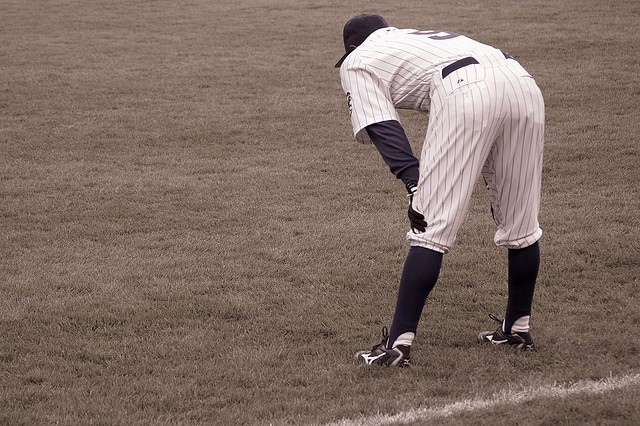
The short black sleeves on Alex Pappas’s jersey were offset by a triptych of white and orange lines near the shoulder. “Yaquis de Obregon” was splashed across the front in a slanted, stylized font, the dark letters bordered in orange. Pappas told the small crowd around the table about how he had hopped the border to get the jersey, which represents a team from a Mexican winter baseball league. The kid next to him, Mike Engle, wore the blue and red of the Montreal Canadiens and offered a tamer story: He’d merely custom-ordered his clothes to look like those of the team’s mascot, and replaced the usual numbers with an exclamation point. But Paul Lukas, whose jeans were rolled up to the knee to reveal striped baseball socks, sipped from a pint glass and quietly listened all the same.
Though millions of college bros and white collar desk jockeys analyze their fantasy football teams each year with the statistical rigor of a top-flight dungeon master, the social centrality of sports mostly insulates its obsessives from any outsider status. But then there are people like Lukas, the fifty-year-old writer behind Uni Watch, ESPN.com’s regular column on sports aesthetics, and his audience — who call themselves the “uni-verse” — close-readers of the visual language with which teams brand themselves through color, pattern and uniform variations. Their debates rage over the relative merits of long and short baseball pants; they catalog minor and major changes to sports clothing; they note trends in typographical size and angle; and they count chevrons and check-patterns.
The gathering, at Brooklyn’s Sheep Station bar last month, was the fifteenth anniversary party for Lukas’ project — a remarkable longevity for what began as a niche column for the Village Voice. “I’ve had a lot of media projects — three years doing this, four years doing that,” Lukas told me. “I am surprised that this has turned out to be the most durable.” Lukas spent much of the nineties writing about industrial and consumer design for outlets like Fortune, New York Magazine and the now-defunct New York Press, covering stories from the naming conventions of fried chicken restaurants to reviews of the world’s shittiest product launches — a beat that Lukas described as “inconspicuous consumption.”
In 1999, Lukas pitched the idea for a regular uniform design column to then-Village Voice sports editor Miles Seligman, whose deliberately off-beat section nestled behind the alt-weekly’s sex ads, featured pieces like regular movie-style reviews of hockey fights. “I think we had a conversation about the button on top of the Mets cap,” Seligman said. “That kind of minutia, both of us were animated and excited to talk about. That’s the kind of thing that we did at the sports section in the Village Voice.” Seligman, who envisioned the column with significant political bent, encouraged Lukas early on to cover the controversy over the Washington Redskins team name, but Lukas preferred to focus on the details of the uniforms themselves. “My goal was to talk about geeky minutia,” Lukas said. (In recent years, however, Uni Watch has taken a strong editorial stance on the naming of the Redskins; it has refused to print the team’s name or logo on membership cards, and it runs a regular feature covering efforts to re-christen the team something less blatantly degrading.)
After the Voice shuttered its sports section in 2003, Lukas’s column was briefly picked up by Slate, before finding a long-term home at ESPN. The site’s unconventional treatment of the sport was initially met by backlash; Uni Watch’s FAQ maintains a section with a pre-emptive rebuke to readers who question Lukas’ sexuality for covering sports in terms of its clothing. But the growth of sports writing that downplays the beat’s competitive masculinity — like the stats-focused offerings of Baseball Prospectus, which published Nate Silver before he targeted his algorithms at national politics — has largely normalized the project, which now has a committed online audience. Over a thousand of Lukas’s readers have shelled out for twenty-five dollars for membership cards.
Marty Buccafusco, on crutches and in a pre-World War II replica baseball jersey, and his wife Jesse, pregnant and in street clothes, told me that the interaction on Lukas’s blog and occasional in-person meetups provide a counterpoint to what had been an isolating hobby. “Before this it was like you sit with a group of people watching sports, and you’ll bring something up like, ‘Wow, that’s weird, these stripes are slightly larger,’ or ‘On Thursdays, the Cowboys have a different color blue in their pants than in their helmet,’” he said. “And everybody’s like, ‘What?’”
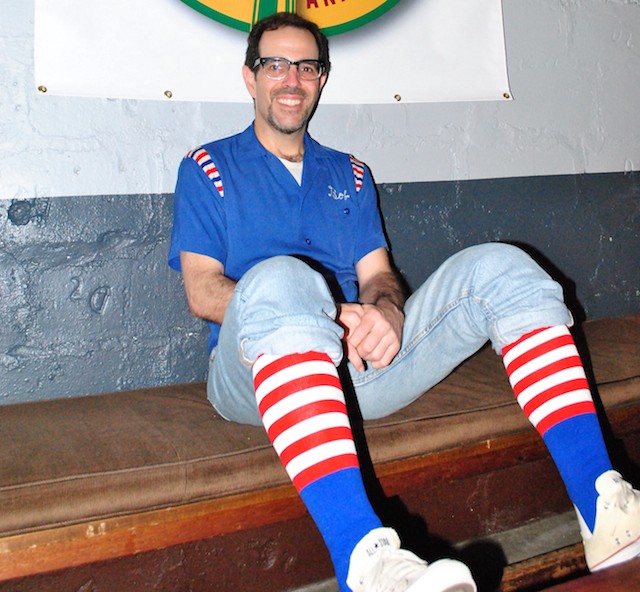
A childhood fascination with the details of baseball was a common thread among the readers at the meet up, whether it had once been train on card collections or hours of baseball broadcasts. Engle, the twenty-year-old in a red and white Montreal Canadiens jersey, described the appeal of seeing a detail he’d never noticed before. “I’ve always been the person who tries to look for the patterns and then the exceptions,” Engle said. “If you’ve seen it, you can never not see it any more.”
It seems an odd subject to inspire passion, but according to Lukas, their interest is rooted in one of the strongest forms of branding out there: the loyalty between fan and team. Lukas cited the Seinfeld bit on sports lovers “rooting for laundry” — the unique pull that keeps Knicks fans buying tickets despite the radical, nepotistic incompetence of owner James Dolan, that has Cubs fans staying Cubs fans despite a legacy of failure that would send near any other product to the discount rack. “That is a completely bizarre and irrational and powerful form of brand loyalty,” Lukas said. “That is the power of the uniform.”
Dan Glaun is a writer living in in Queens.
Photos by Jake and Leigh Greaney, respectively.
New York City, July 10, 2014

★★★★ An unexpected sampling of ways not to be unpleasant. The orbital muscles got ready to tighten and then relaxed, in the gentle light of a damp-aired morning. Mellow gray overtook the sky for a long spell, keeping the streets cool. Then abruptly there was almost-full warm sun. The light was clear; the sidewalks were full. Toward sundown, uptown, the neutral gray had come back again. Was air conditioning dripping, or was rain starting to fall? By the end of a trip through the grocery, in and then out on a wide-open express lane, the gray appeared to be resolving back to blue, in the ambiguous tones of dusk. Either way, the far-away west was streaked with glowing pink.
The State of the Media is Strong or Maybe the Opposite of Strong
“Shares in the Times rose/fell tk to tk as of tk time on Friday.”
Just Lie to Yourself: Science
[Scientists] found similar differences among another group of campers, who were instructed to to listen to music as they walked. The guide told them to focus on the music, asking them, for instance, where they heard the music more clearly.Wansink documented that the music-focused walkers consumed far fewer M&M;’s offered up as a snack after the stroll, compared to participants who had just focused on the exercise of walking.
Some other possible life tips based on this research: While at work, drink — your shift will feel like a party, and you won’t need to go out afterward. Instead of “doing chores” around the house, tell your friends, and yourself, that you’re preparing to move out every two weeks. Then just don’t! The possibilities are endless, as long as you remain unaware of as many of them as possible.
This Week in Lines
by Jake Gallagher
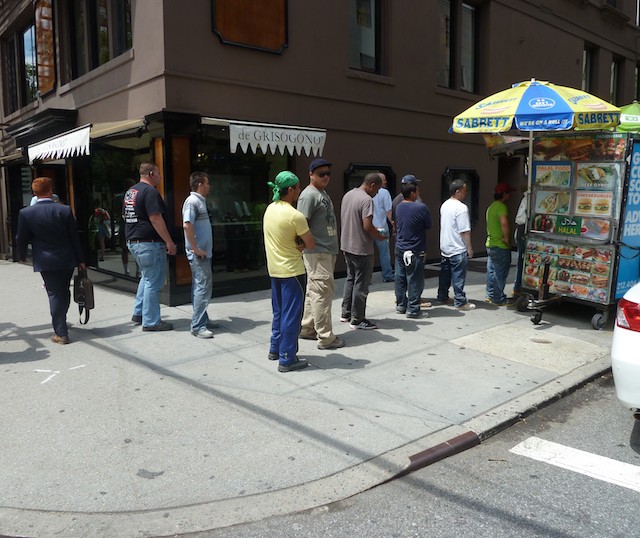
12:03 PM Wednesday, July 9th — Halal Cart, 69th and Madison
Length: 11 people
Weather: 81 degrees and partly cloudy
Crowd: Construction workers
Mood: Distracted
Wait Time: Approximately seven minutes
Lingering Question: How many Halal carts can one neighborhood sustain?
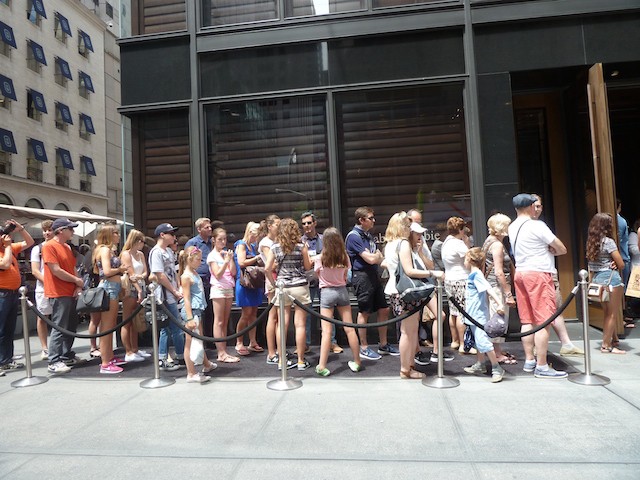
12:18 Wednesday, July 9th — Abercrombie & Fitch, 56th & Park
Length: 32 people
Weather: 81 and partly cloudy
Crowd: A mix of American teenage girls with potbellied parents, sunburnt European tourists, and camera toting Japanese tourists.
Mood: Anxious and preoccupied. I got the sense that no one, even the kids really had any idea why they were there.
Wait time: Right after this photo was taken almost the entire line was allowed in, which leads me to believe this is a strategy by the store to always maintain the facade of foot traffic.
Lingering Question: How are people still being conned into waiting in this line?
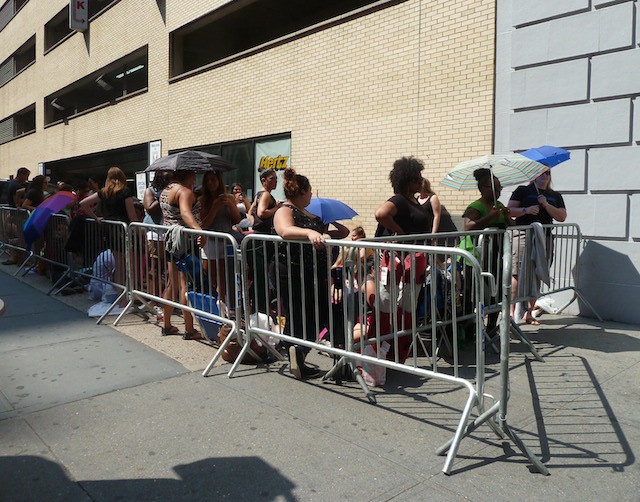
3:08 Thursday, July 10th — Justin Timberlake tickets at Hammerstein Ballroom, West 34th and 9th
Length: Roughly 130 people divided between three separate fenced off areas.
Weather: 81 and mostly cloudy
Crowd: 90 percent women of all ages. 5 percent bored looking scalpers. 97.3 percent oversized plastic sunglasses.
Mood: Near the front, the veterans chattered gleefully amongst each other like sorority sisters of the house JT. They had come prepared with lawn chairs, umbrellas, and enough food to last them through a weeklong engagement, but the back was another story. The empty-handed newcomers appeared comparatively ill-prepared for the wait ahead, and a number of them assumed the Charlie Brown stance as they took their place at the rear.
Wait Time: 4–5 more hours.
Lingering Question: How long will a phone last if you take one selfie every minute capturing the slowly setting sun in the background while waiting to enter a Justin Timberlake concert?
Jake Gallagher is a writer for A Continuous Lean and other places.
